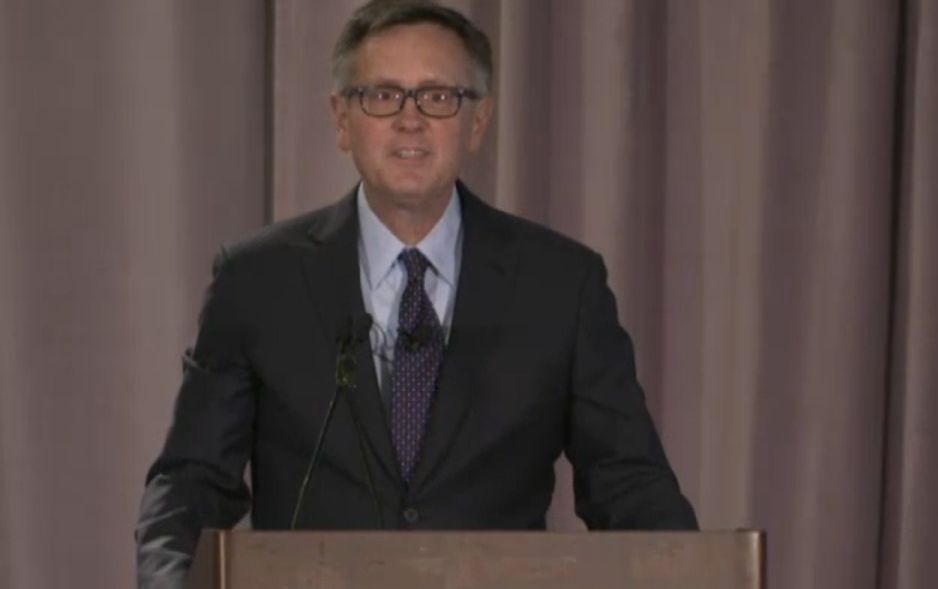Vice Chair Richard H. Clarida
The COVID-19 pandemic and the mitigation efforts put in place to contain it delivered the most severe blow to the U.S. and global economies since the Great Depression.1 Gross domestic product (GDP) collapsed at a nearly 33 percent annual rate in the second quarter of 2020. More than 22 million jobs were lost in just the first two months of the crisis, and the unemployment rate rose from a 50-year low of 3.5 percent in February to a postwar peak of almost 15 percent in April 2020. A precipitous decline in aggregate demand pummeled the consumer price level. The resulting disruptions to economic activity significantly tightened financial conditions and impaired the flow of credit to U.S. households and businesses.
The fiscal and monetary policy response in the United States to the COVID crisis was unprecedented in its scale, scope, and speed. Legislation passed by the Congress in March 2020, December 2020, and March 2021 provided a total of nearly $5.8 trillion in fiscal support to the U.S. economy—about 28 percent of U.S. GDP.2
The Federal Reserve acted decisively and with dispatch to deploy each and every tool in its conventional kit and to design, develop, and launch within weeks a series of innovative facilities to support the flow of credit to households and business. The facilities the Federal Reserve either relaunched or designed and developed anew in response to the COVID crisis were established under the authority of section 13(3) of the Federal Reserve Act; under section 13(3), these facilities can be established only in „unusual and exigent circumstances” and with approval of the Treasury Secretary.3
The Global Pandemic Collapse (GPC) in the spring of 2020 was the second occasion in the past dozen years in which the Federal Reserve invoked its emergency lending powers to help forestall severe financial market disruptions—the first occasion being the Global Financial Crisis (GFC) of 2008–09. In my remarks today, I would like to reflect on the Federal Reserve’s response to the GPC in the context of our institution’s history and structure and to highlight not only the privileges that flow from, but also the responsibilities that are required to respect, our institutional independence.
Origins of the Federal Reserve
Let’s begin with some history. At the urging of Treasury Secretary Alexander Hamilton, the First Congress of the United States established the First Bank of the United States in 1791. Like similar institutions in other countries—most notably, the Bank of England—the First Bank of the United States was owned by the private sector, was publicly chartered, and carried out some of the operations that would be thought of today as those of a central bank.4 That First Bank played a key role in executing Hamilton’s vision to put the young federal government’s finances on a sound footing, to promote the stabilization of the purchasing power of the U.S. dollar, and to support economic growth. Nevertheless, that First Bank became embroiled in politics, and the Congress failed to renew its 20-year charter in 1811. In 1816, the Congress did charter a Second Bank of the United States, which was designed along similar lines to its predecessor. But it, too, generated political controversy—Andrew Jackson was not a fan and was not shy in saying so—and its 20-year charter expired without renewal in 1836.
For the next 77 years, the United States operated without a central bank. There was significant financial-sector development during this time, with commercial banks, equity markets, and corporate bond markets all playing a growing role in financial intermediation in the U.S. economy. This period also witnessed several major financial panics that substantially disrupted economic activity.5 One of those panics—the Panic of 1907—galvanized the Congress to establish a new central bank. The Federal Reserve was charted by the Congress in 1913 and directed specifically to promote the stability of the financial system. An important goal of the Federal Reserve in those early years was to smooth the large seasonal swings in interest rates and credit conditions associated with the harvest season that, in the past, had contributed to financial panics. The principal tool provided in the Federal Reserve Act to accomplish this goal was the ability of the Federal Reserve to lend funds to commercial banks against sound collateral through its „discount window.” 6
Through the compromises and choices made in designing the Federal Reserve system, the Congress created an institution that received broader and more durable political support than had been the case for the First and Second Banks of the United States. At the center of the Federal Reserve System was the Federal Reserve Board, which was composed of public officials nominated by the President and confirmed by the Senate. In this initial incarnation, the Board included the Secretary of the Treasury as an ex officio member. The Federal Reserve System also included 12 Reserve Banks—distributed across a dozen geographic Districts—which were designed to be responsive to and report on regional economic conditions.
Although the Congress assigned the Federal Reserve a statutory set of goals and tools, policymakers from the very first days had substantial independence in how they used those tools to pursue the assigned goals. For example, the interest rate charged on discount window loans—rates that had an important bearing on overall financial conditions in the country—was set by Federal Reserve policymakers, with little interference from the Congress or the executive branch. The same was true of Federal Reserve purchases or sales of Treasury securities. These open market transactions were found, over time, to be another effective tool with which to influence overall financial conditions.
The Great Depression and Changes to the Structure of the Federal Reserve
In response to the Great Depression and reflecting a growing recognition that the Federal Reserve’s original institutional design was in need of improvement, the Congress restructured the Federal Reserve System in the 1930s.7 Greater authority over policy decisions was placed with the Board—whose members, given their presidential nomination and Senate confirmation, were thought to be more clearly accountable to the nation as a whole. At the same time, the Congress gave the Board increased independence from the executive branch by removing the Secretary of the Treasury’s status as an ex officio member. Decisions regarding open market purchases of U.S. government securities, which were becoming the most important monetary policy tool of the Federal Reserve, were assigned to the Federal Open Market Committee (FOMC), which consists of the members of the Board of Governors and a rotating subset of the Reserve Bank presidents. In the FOMC structure set up in the mid-1930s and remaining in force today, only five Reserve Bank presidents are voting members of the FOMC at any one time, leaving the seven Board Governors typically in a majority position. This arrangement has served the Federal Reserve well during the past 85 years, as it promotes a diversity of views and a healthy debate regarding the policy options available. It is also worth noting a distinction that bears on decisionmaking powers regarding monetary policy and lending policy. In contrast to monetary policy, the power to make decisions about the structure of Federal Reserve lending programs, including the authority to launch emergency programs, resides solely with the Board.
Subsequent decades saw further changes to the governance of monetary policy. A notable development occurred in 1951, when the Federal Reserve obtained its current level of independence from the Treasury Department on monetary policy, as codified in the Treasury–Federal Reserve Accord. Another milestone occurred with the Federal Reserve Reform Act of 1977, which assigned the Federal Reserve its current statutory mandate to achieve price stability and maximum employment.9 Monetary policy had, in effect, pursued these goals since the accord, and the Federal Reserve’s maximum-employment and price-stability goals had been embedded in previous acts of the Congress. But the statutory formalization of this „dual mandate” was important in specifying congressional intent and defining the Fed’s goals.
In the decades after the Great Depression, while systemic financial disruptions in the United States were not unknown—the Latin American debt crisis of the 1980s and the savings and loan crisis of the 1990s were certainly major events—systemic liquidity crises were relatively uncommon. And the Federal Reserve was able to address the disturbances that did occur using its traditional tools of providing discount window loans to banks, a tool that had been in its toolkit since 1913.
The Global Financial Crisis
This half-century of relative financial stability in the United States was shattered in 2008 by the GFC, a crisis that disrupted financial markets and impaired financial intermediation around the world. In the United States, many of the most severe disruptions occurred in wholesale funding markets and involved nonbank financial firms—such as broker-dealers, money market funds, nonbank mortgage lenders, and nonbank finance companies. These nonbank financial institutions, which had become a major source of financial intermediation in the United States in the decades leading up to the GFC, were typically lightly regulated, highly leveraged, and overly reliant on unstable sources of short-term funding. And because they were not banks, the Federal Reserve would have faced enormous challenges stemming the crisis solely by use of traditional discount window lending to depository institutions.
Funding markets during the GFC faced enormous stress. A number of major financial firms failed, Fannie Mae and Freddie Mac were forced into conservatorship, and the flow of credit to businesses and households was severely impaired. The Federal Reserve responded by using not only its traditional authority to lend to banks, but also, for the first time, its authority to lend to nonbank institutions under section 13(3) of the Federal Reserve Act in unusual and exigent circumstances. The GFC emergency lending facilities that were stood up under this authority were designed to support short-term funding markets and to provide loans to nonbank financial firms, which in turn could then continue to intermediate credit to the private sector.10 The Federal Reserve also made section 13(3) loans to individual distressed nonbank firms, like Bear Stearns and the American International Group, Inc., or AIG.
The Federal Reserve’s emergency lending programs established during the GFC stabilized the financial system and helped prevent another great Depression. Consistent with the central bank’s statutory authority, the facilities were designed to minimize the Federal Reserve’s exposure to credit risk, and all of the facilities were wound down over time without any loss to taxpayers.
In the wake of the GFC, the Congress made several changes to the Federal Reserve’s emergency lending authority. First, the Federal Reserve would be required to provide loans to nonbanks only through broad-based facilities: Bilateral loans to individual nonbank firms were no longer permissible. Second, all emergency lending programs would now require approval by the Secretary of the Treasury. Third, the Federal Reserve going forward would be required to provide enhanced and timely transparency with regard to any emergency lending facilities set up under section 13(3). In addition to these changes to the Federal Reserve’s authority, the GFC also spurred wide-ranging financial regulatory reforms—in particular, the Dodd-Frank Wall Street Reform and Consumer Protection Act—meant to improve the stability of the financial system.
The Federal Reserve’s experience in the GFC reinforced a set of important principles guiding how it would respond to a future systemic financial crisis:
Act rapidly and decisively.
Act on a large scale with a variety of tools.
Be mindful that announcement effects can be vital for promoting confidence.
Design and price facilities as backstops to smooth a return to private-sector financial intermediation as quickly as possible.
Response to the Global Pandemic Collapse
The lessons learned from the Federal Reserve’s response to the GFC were invaluable, as it had to assess, develop, and execute its response to the GPC in a matter of weeks.11 In the first two weeks of March 2020, the FOMC lowered its target range for the federal funds rate by 1 1/2 percentage points, thereby bringing the range to its effective lower bound of 0 to 1/4 percent. The Committee also provided forward guidance on the federal funds rate, stating that it expected to maintain the existing target range until it was confident that the economy had weathered recent events and was on track to achieve its maximum-employment and price-stability goals.12 In addition, the Federal Reserve engaged in substantial purchases of Treasury securities and agency mortgage-backed securities to support market functioning and further ease financial conditions.
Reflecting the heightened uncertainty of mid-March 2020, there was a surge in demand for liquidity across the global financial system. Spreads in some short-term credit markets, such as that for commercial paper, surged to levels nearing those of the 2008 financial crisis; investors ran on prime and tax-exempt money funds; and some firms found it difficult to obtain the credit needed to finance critical operations. Many businesses sought to draw down on lines of credit with banks to augment the amount of liquidity they had readily available. To relieve these strains, the Federal Reserve encouraged depository institutions to turn to the discount window, lowered the rate on discount window borrowing, and made it easier for institutions to borrow from the Federal Reserve at longer maturities. As conditions in U.S. credit markets were severely stressed, the Board determined once again that circumstances were unusual and exigent and acted rapidly and decisively to prevent financial collapse. With approval of the Treasury—and, in some cases, drawing on equity capital invested by the Treasury—the Board announced and stood up several section 13(3) short-term liquidity facilities similar to those established during the GFC.13 And because dollar funding pressures were not limited to the United States, the Federal Reserve stabilized global dollar funding markets by expanding its swap line arrangements with foreign central banks and by lending dollars against U.S. Treasury securities to foreign central banks.
Against the background of concerns about major economic disruptions stemming from the pandemic, strains also emerged in the corporate bond market, the municipal debt market, and asset-backed securities markets. Issuance of new debt in these markets slowed sharply, and the cost of corporate credit increased considerably. Financing challenges were also faced by state and local governments as well as by small and medium-sized businesses traditionally reliant on bank lending.
In response to the crisis, the Congress passed the Coronavirus Aid, Relief, and Economic Security Act, or CARES Act, in late March 2020. The legislation authorized the Treasury to make sizable equity investments in Federal Reserve section 13(3) facilities. On the basis of this legislation, the Federal Reserve established several novel section 13(3) lending facilities to promote intermediation in credit markets. Among other measures, the Federal Reserve purchased corporate bonds in the secondary market under the corporate credit facilities, made loans to smaller nonfinancial companies through the Main Street Lending Program, and made loans to state and local governments through the Municipal Liquidity Facility.
These section 13(3) facilities promoted the flow of credit to households and businesses and helped stabilize financial and economic conditions. It is notable that they accomplished their goals even though credit provided by the facilities was priced in a manner consistent with their status as backstops rather than as full-fledged replacements for private-sector intermediation. Indeed, some facilities recorded little or no use. But their very existence as backstops appears to have contributed in substantial ways to calming markets and promoted the revival of activity in private credit markets as conditions normalized.
The public health policy response to contain the COVID-19 virus triggered an unprecedented disruption to the U.S. economy. The economic policy response to the crisis was equally unprecedented. As I have described, because of the breadth and depth of the dislocations in the U.S. financial system caused by the GPC, the Federal Reserve’s credit facilities had to be designed to reach counterparties well beyond those associated with its traditional lending facilities. The Federal Reserve’s actions during the GPC were taken to fulfill its long-standing statutory mandate to stem financial panics. The facilities established in 2020, in conjunction with the Federal Reserve’s other actions and a robust fiscal policy response, provided crucial support to the U.S. economy as GDP was collapsing and unemployment was surging. Then, as the distress in financial markets abated and the economy regained its footing, the facilities were wound down and the emergency tools were, appropriately, put back in the toolbox with no adverse impact on credit conditions. For example, the Federal Reserve completed its sales of assets from the Secondary Market Corporate Credit Facility on August 31. Similarly, we are managing the paydown of assets in our other CARES Act facilities as they wind down over time (see the Table).
Concluding Remarks
In conclusion, in central banking, as in other endeavors, with privilege comes responsibility. The Federal Reserve recognizes and has acted according to the principle that its section 13(3) authorities are to be deployed only in unusual and exigent circumstances, and, in both the GFC and GPC, it took its responsibilities seriously and did so in a timely way. Outside of such circumstances, the Federal Reserve has been granted instrument independence by the Congress to set short-term interest rates and to purchase and sell U.S. government securities to achieve its statutorily assigned goals of maximum employment and price stability. Thank you for your time and attention, and I look forward to my conversation with President Mester.






COMMENTS